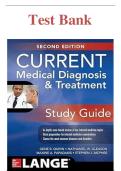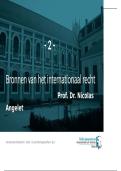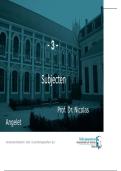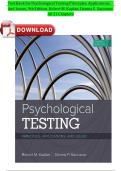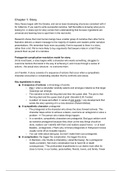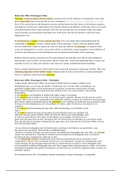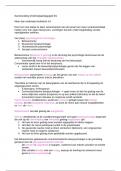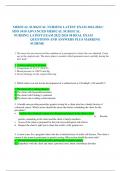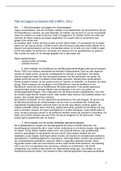Oceans are important because of the species that live in the ocean (2 million). Besides they
play a massive role with climate, they absorb the heat and transport salt. They also play a
big role in biochemical cycles like the carbon cycle, and we get a lot of natural resources
from the ocean. It is also very important for our economy.
There are 3 major marine sciences themes: physical, chemical, biological, and pale-
oceanography (time scales of change). Oceans are changing due to pollution, warming,
acidification and anoxia.
Lecture 1B: Warming, Acidification and Anoxia
Modern perturbation of the carbon cycle
The global carbon project consists of scientists. As mission they have: assisting the
international science community to establish a common, mutually agreed knowledge base
to support policy debate and action to slow the rate of production of greenhouse gases.
In 2011 – 2020 there has been an influx of 35 gigatons of CO2 into the atmosphere due to
use of fossil fuels. Due to land use change (deforestation) 4 gigatons of CO2 reached the
atmosphere. The biosphere has taken up 11 gigatons and the ocean 10 gigatons. The
atmosphere has therefore had a nett influx of 19 gigatons of CO2. The CO2 in the
atmosphere is still increasing but the growth is declining. CO2 emission from deforestation
is stable, but emission from fossil fuel use is still increasing.
The most used fossil fuel is coal, but oil and gas are also used a lot. Renewable energy is
growing exponentially, but not fast enough to offset the growth of fossil energy
consumption.
About 90% of the CO2 sources are fossil fuels and 10% are deforestation. About 50% of this
CO2 ends up in the atmosphere, 30% in biomass and 25% in the ocean.
Carbon ends up in deeper water layers due to density-based circulation (deep water
formation). The surface ocean becomes so dense that it sinks.
CO2 in the ocean undergoes carbonation. When there is an increase in dissolved CO2, there
is a decrease in carbonate and an increase in bicarbonate. So, there is an increase in
dissolved inorganic carbon. This causes an increase in hydrogen ions and therefore
acidification. With an increase of DIC (CO2) there will be a decrease of the pH.
Lecture 1C: Warming, Acidification and Anoxia
With depth oxygen decreases and CO2 increases. Surface ocean is in oxygen equilibrium
with the atmosphere, this is supplied to deeper layers with circulation. This oxygen is
consumed through respiration of organic carbon and that carbon is exported to deeper
water layers. This is called the biological pump.
,Biological pump
The solubility pump is 1/3 of this oxygen and CO2 gradient. This is based on the fact that the
solubility of gases increases at a lower temperature. The rest of the gradient is based on the
biological pump. This consists of 2 parts. The first one is the organic carbon (soft tissue)
pump: CO2 dissolves in surface layers, is used with primary productivity, this is exported to
deeper layers, where it is respired, CO2 is released, and oxygen consumed. The second one
is the carbonate counter pump: with production of calcium carbonate, one molecule of CO2
is also produced, this is exported to the atmosphere.
Gross primary production is the total rate of carbon fixation by phytoplankton. A part of this
is used for respiration by phytoplankton, the other part is the net primary production.
Only a very small part of the primary production is ultimately buried in the sediment.
The E-ratio shows the export production / net primary production. So, it shows the
component of the NPP that is exported to deeper layers. With a warmer ocean, more
primary production is respired in surface layers, so less CO2 is exported, and the e-ratio is
lower. The magnitude of the NPP is also important because with a higher NPP, the e-ratio is
also higher.
Upwelling regions have more export of CO2 of the ocean into the atmosphere because CO2
of deeper layers is brought up to the surface. But there is also more primary productivity
that leads to more export. Regions with more export of CO2 into the ocean are colder.
Therefore, the solubility of gases (CO2) is higher, and more CO2 is taken up into the ocean.
High nutrient, low chlorophyll regions may have macronutrients available but are missing
other essential elements, which causes less productivity.
Ocean acidification stimulates primary productivity and export and limits calcite production
and therefore there will be less CO2 production.
CO2 uptake in the future can increase because of CO2 stimulated growth of phytoplankton
and less calcification. But it can also decrease because of a decline in buffer capacity and
warming and stratification.
Lecture 2: Climate change assessed by the IPCC
IPCC is a group of scientists that collect scientific articles. There are 3 working groups:
Working group I: assesses the physical science of climate change
Working group II: assesses the vulnerability of socio-economic and natural systems to
climate change, negative and positive consequences of climate change and options for
adapting to it
Working group III: focuses on climate change mitigation, assessing methods for reducing
greenhouse gas emissions and removing greenhouse gases from the atmosphere
The surface temperature was pretty stable but since 1850 it has been rising rapidly.
In articles the terms agreement and evidence are used often. Agreement means to what
extend studies agree with each other and evidence means physical evidence.
, Global warming isn't the same everywhere, Greenland is actually cooling (changes in ocean
current, but multiple hypotheses). Inner parts are warming faster than outer parts and
continents are warming faster than oceans because water of the ocean that evaporates
cools the surface.
Net radiation is unbalanced, there is more incoming radiation than outgoing radiation.
Therefore, the atmosphere should be 15 degrees warmer but is only 1 degree warmer.
Resulting extra heat has been absorbed by the ocean, the energy has gone into the melting
of ice and the warming of the ocean.
The North Atlantic is cooling so the heat uptake is higher, and it takes up more CO2.
Multidecadal oscillations: During - IPO there is less global warming because the oceans can
have a higher heat uptake. During + IPO it is the other way around.
Annual precipitation (rain) over land
- Expectation is more precipitation because of water evaporation
- Dry regions are getting even more dry
- Wet regions are getting wetter
- It will become more seasonal
- Overall, it's getting wetter
Ocean deoxygenation
Henry's law: at a constant temperature, the amount of a given gas that dissolves in a given
type and volume of liquid is directly proportional to the partial pressure of that gas in
equilibrium with that liquid. This means that gases dissolve easier in colder waters.
There’s lots of oxygen in the surface water but drops at depth because of respiration and no
photosynthesis. Then oxygen slowly increases in depth because of ocean currents.
Apparent oxygen utilization: equilibrium saturation – actual oxygen concentration.
This number is small when waters are well in contact with the atmosphere.
Upwelling regions have very little oxygen at the oxygen minimum zone. The oxygen
minimum zone is where the oxygen saturation is at its lowest.
Deep sea anoxic basins in the Mediterranean Sea are formed by evaporite salt deposits
dissolving out of the Mediterranean ridge and collecting in abyssal depressions. The
salinity is higher than in the normal ocean, which prevents mixing with overlying oxygenated
waters, so they are almost anoxic.
Fjords: limited exchange of seawater and thus water circulation, this also leads to
stratification and anoxia.
Consequences for oxygen:
- Oxygen solubility decreases

